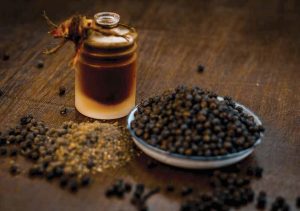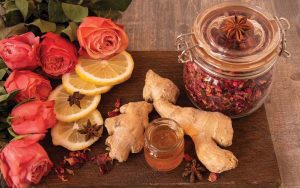Essential Oils In The Kitchen January 7, 2021
Mandy Aftel On Flavour and Fragrance Crossovers
 Mandy Aftel is a revered California-based perfumer who only uses naturals in her work – a choice she made early on in her career that not only influences the end olfactory results of her products but also encourages innovative approaches and contexts for using essential oils. She was one of the first in the industry to format and package natural essences traditional in perfumery specifically for use in fine dining kitchens and mixology stations, anticipating today’s multisensory trend by almost two decades – her “Chef’s Essences” are all-natural oils that she describes as “concentrated flavours [that] have the upper hand on spices and herbs; they outlive their traditional pantry counterparts and deliver a cleaner flavour”.
Mandy Aftel is a revered California-based perfumer who only uses naturals in her work – a choice she made early on in her career that not only influences the end olfactory results of her products but also encourages innovative approaches and contexts for using essential oils. She was one of the first in the industry to format and package natural essences traditional in perfumery specifically for use in fine dining kitchens and mixology stations, anticipating today’s multisensory trend by almost two decades – her “Chef’s Essences” are all-natural oils that she describes as “concentrated flavours [that] have the upper hand on spices and herbs; they outlive their traditional pantry counterparts and deliver a cleaner flavour”.
This interview delves into Mandy’s cross-industrial mind, exploring her love of naturals and reviewing the benefits and surprises inherent to applying essential oils in gastronomic settings.
They (essential oils) are, for me, beautiful ingredients to work with, even the stinky, funky ones. I sit and wonder at the complexity of nature – they fire me up and they make me happy.
Eddie Bulliqi [EB]: What initially drew you to this industry and at what point did you choose to work with naturals only?
 Mandy Aftel [MA]: I had no intention of becoming a perfumer – I was a psychologist specialised in artists, writers and creative people. I first began researching perfume when I decided to make the main character of a novel I was working on a perfumer. Starting in old bookstores delving through catalogues on aromatherapy and botanicals, I took an aromatherapy class and was hooked on the value of naturals. I loved their history, how it was intertwined with us, with human beings as a species, and was fascinated that you could get your hands on things that carried so much reverence so far back in time. To me, these natural materials were near-universal and incredibly complex. It sparked inspiration in my mind that you could do amazing things with them in the perfumery world in the same way as in the food world, celebrating them just how a perfect tomato or truffle oil deserves to be celebrated. I just love the complexity of natural aromas and I have never felt limited by them. I’m not against synthetics, I just love naturals.
Mandy Aftel [MA]: I had no intention of becoming a perfumer – I was a psychologist specialised in artists, writers and creative people. I first began researching perfume when I decided to make the main character of a novel I was working on a perfumer. Starting in old bookstores delving through catalogues on aromatherapy and botanicals, I took an aromatherapy class and was hooked on the value of naturals. I loved their history, how it was intertwined with us, with human beings as a species, and was fascinated that you could get your hands on things that carried so much reverence so far back in time. To me, these natural materials were near-universal and incredibly complex. It sparked inspiration in my mind that you could do amazing things with them in the perfumery world in the same way as in the food world, celebrating them just how a perfect tomato or truffle oil deserves to be celebrated. I just love the complexity of natural aromas and I have never felt limited by them. I’m not against synthetics, I just love naturals.
EB: What do you enjoy the most about working with essential oils?
MA: Because they’re so complicated, with so many aroma facets inside them, they smell very intricate to me. I have really enjoyed the process of figuring out how to work with them through what I believe is both a very cerebral art practice and a genuinely sensual experience. They are, for me, beautiful ingredients to work with, even the stinky, funky ones. I sit and wonder at the complexity of nature – they fire me up and they make me happy.
 EB: Do you use essential oils in any functional contexts in your life – for example, to ease stress or aid sleep?
EB: Do you use essential oils in any functional contexts in your life – for example, to ease stress or aid sleep?
MA: I do it in a personal and intuitive way, in terms of using them in cooking, for example. I find that they change everything I cook. But I use the materials mostly for their beauty to create something beautiful; although, anecdotally, working with them completely changes my mood. At times in my life when I’ve been sad or troubled, by the end of my work session I feel a lot better.
EB: What about your customers – are you increasingly or less frequently being asked about the functional properties of the oils you select?
MA: I have found, since COVID-19 began, a huge increase in the number of notes on orders saying how much my oils have helped my customers through this time by engaging with them in a therapeutic context.
EB: It was rare to hear of chefs implementing essential oils into their cooking when you yourself began developing your Chef’s Essences. What factors led you to think of applying erfumery principles to gastronomic frameworks?
MA: In essence, it was because I realised that I wanted to speak to and work with people who were concerned about the integrity of ingredients and natural ingredients in particular. I live near the restaurant Chez Panisse and asked a friend of founder-chef Alice Waters to recommend someone to me who would be interested in an essential oil project. I ended up bringing some oils for the two-Michelin-star chef Daniel Patterson to smell and he was blown away – particularly by the black pepper essential oil which has many facets of aroma and taste that are not evident in peppercorns themselves when included in a recipe, often dusty and hot in their original form.
The heat you experience when eating peppercorns doesn’t travel to the essential oil, giving it an entirely new flavour. I see the use of saffron absolute in cooking in the same way – the raw spice is classically added at the beginning of the cook to impart its flavour but a few drops of absolute at the end of cooking retains much greater vibrancy from the ingredient.
 EB: Do you see specific trends in this realm – certain oils that have become particularly popular in mixologist circles or within fine dining, for example?
EB: Do you see specific trends in this realm – certain oils that have become particularly popular in mixologist circles or within fine dining, for example?
MA: One thing I notice is that people tend to start in one place and then they branch out with a spirit of experimentation, looking for unusual combinations. I’ve also noticed a lot of dessert chefs buying pine needle absolute, whilst savoury chefs have been very interested in my mushroom spray.
EB: How do you think your Chef’s Essences stimulate new approaches to flavour that aren’t as obvious when using raw food ingredients?
MA: I use my basil essential oil in tomato sauce as I don’t have basil growing and if I buy a whole head I usually waste a lot of it. One way it changes your interaction with food is that it allows you to access flavour you may not have to hand in an easy and thrilling way – with one or two drops balancing a recipe. One or two drops change everything about the taste, adding extra excitement to the cooking experience.
Also, some people still own sp ices passed down from their grandmother! With old spices, most of their oil is not there or not active. With essential oils in the kitchen, you can get the beauty of fresh ingredients when you don’t have them or when accessing their flavour is difficult – for example, dried mint is not nearly as interesting as a drop of spearmint oil. The flavour vibrancy of naturals is fully retained in the oil and you can add it to a dish without affecting its texture nor liquidity. I also think of ginger here – dried ginger can taste stale, but ginger oil, distilled from fresh ginger, is citrusy and buoyant.
ices passed down from their grandmother! With old spices, most of their oil is not there or not active. With essential oils in the kitchen, you can get the beauty of fresh ingredients when you don’t have them or when accessing their flavour is difficult – for example, dried mint is not nearly as interesting as a drop of spearmint oil. The flavour vibrancy of naturals is fully retained in the oil and you can add it to a dish without affecting its texture nor liquidity. I also think of ginger here – dried ginger can taste stale, but ginger oil, distilled from fresh ginger, is citrusy and buoyant.
EB: How do you advise customers to avoid overdosing in recipes and avoiding unforeseen negative consequences when ingesting natural essences?
MA: We are very careful about what we do offer and are stringent about asking people to put the drops onto a spoon and count them, never advising more than two or so drops at first. It’s about starting small and going from there. With my sprays, which are pre-diluted and more for finishing food or cocktails, it’s almost impossible to mess up.
EB: Finally, what’s your current favourite recipe that you feel is transformed through the use of essential oils?
Here’s one I love from my 2004 book with Daniel Patterson: Aroma: The Magic of Essential Oils in Food and Fragrance.
ROSE AND GINGER SOUFFLÉ: SERVES 8
This soufflé is based on yoghurt instead of the traditional pastry cream, which gives the soufflé incredible lightness and a subtle tanginess. It is easy to make, and the aroma of the rose intermingled with the ginger is unforgettable.
 Ingredients:
Ingredients:
- Unsalted butter, for buttering baking dishes
- Sugar, for dusting baking dishes
- 1 cup plain whole-milk yoghurt
- 2 large egg yolks
- 1 tablespoon fresh blood orange juice
- 10 drops rose absolute
- 13 drops fresh ginger essential oil
- 1 cup large egg whites
- ¾ cup confectioners’ sugar
- Salt
Butter and sugar eight 4-ounce soufflé moulds or ovenproof ceramic cups. In a mixing bowl, combine the yoghurt, egg yolks, blood orange juice and essences.
Preheat the oven to 325F/165C. In a mixer fitted with a whisk attachment, beat the whites on low speed with half of the sugar and a pinch of salt until they form soft peaks. Add the rest of the sugar and continue beating until the whites form stiff peaks.
Carefully fold 1/3 of the whites into the yoghurt base. Do not overmix. Fold in the rest of the whites until just combined and ladle into the soufflé moulds. Fill the moulds completely and then run your thumb around the top edge of the rim to create a slight indentation in the soufflé mixture. Bake until set but still moist inside, about 10 minutes. Serve hot in the soufflé moulds.
Enjoy!
 Ultra International B.V.
Ultra International B.V.